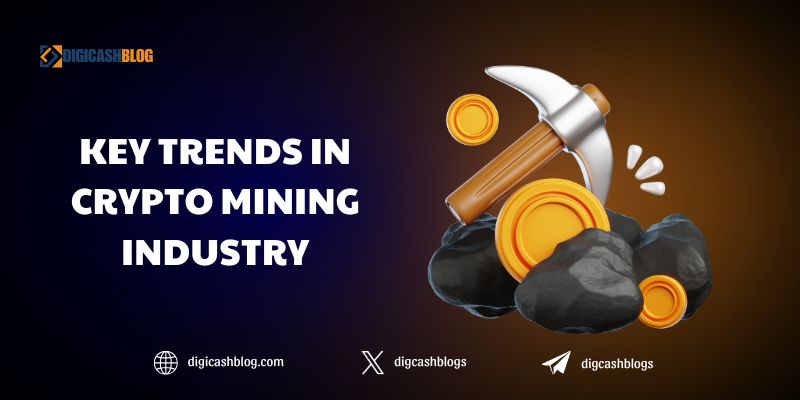In recent years, key trends in crypto mining industry have evolved significantly, driven by technological advancements, regulatory shifts, and environmental concerns. The crypto mining landscape is undergoing rapid changes, affecting miners, investors, and blockchain networks globally.
This article delves into key trends in crypto mining industry, exploring topics such as the rise of energy-efficient mining solutions, institutional involvement, regulatory impacts, and the shift toward decentralized mining models. Understanding these trends is crucial for anyone involved in cryptocurrency mining and blockchain technology.

Understanding the Crypto Mining Industry
What Is Crypto Mining?
Crypto mining is the process of validating transactions and securing blockchain networks using computational power. Miners solve complex mathematical puzzles to add new blocks to the blockchain, receiving cryptocurrency rewards in return. This process underpins the security and decentralization of blockchain networks like Bitcoin and Ethereum.
The Role of Mining in the Blockchain Ecosystem
Mining ensures network integrity, prevents double-spending, and facilitates trustless transactions. With the growing adoption of cryptocurrencies, mining has become a crucial component of the digital financial ecosystem.
Key Trends in Crypto Mining Industry
The Shift to Energy-Efficient Mining
One of the most important key trends in crypto mining industry is the move toward energy-efficient mining solutions. With growing concerns over the environmental impact of proof-of-work (PoW) mining, companies are developing:
Renewable energy mining farms that leverage solar, wind, and hydroelectric power.
Advanced ASIC chips designed to consume less power while maintaining high computational efficiency.
Mining pools promoting carbon neutrality by offsetting emissions.
The transition to greener mining solutions is gaining momentum as governments and environmental organizations scrutinize the industry’s carbon footprint.
Institutional Investment in Mining Operations
Institutional investors are increasingly participating in crypto mining operations. Hedge funds, private equity firms, and publicly traded mining companies are injecting capital into:
Large-scale mining farms with state-of-the-art infrastructure.
Joint ventures with energy companies to secure long-term, cost-effective power sources.
Development of mining-centric financial products, such as mining-backed tokens and derivatives.
This institutional involvement is professionalizing the mining sector and driving further innovation in mining hardware and efficiency.
The Impact of Regulatory Changes
Regulatory developments are reshaping key trends in crypto mining industry, with governments worldwide implementing policies that affect mining operations. Key regulatory factors include:
Bans and restrictions on mining in regions like China, forcing miners to relocate to crypto-friendly jurisdictions such as the U.S., Canada, and Kazakhstan.
Licensing and compliance requirements in various countries to ensure transparency and taxation compliance.
Incentives for sustainable mining, such as tax benefits for using renewable energy sources.
Navigating these regulatory landscapes is crucial for mining companies seeking long-term viability.

Technological Advancements in Mining
AI and Automation in Mining
Artificial intelligence (AI) and automation are transforming crypto mining by optimizing mining operations and reducing costs. AI-driven mining software helps:
Enhance hardware performance by predicting maintenance needs.
Optimize mining algorithms to maximize rewards while minimizing energy consumption.
Improve security by detecting malicious attacks on mining pools and networks.
Decentralized Mining and Home Mining Revival
A growing movement toward decentralized mining is emerging, encouraging smaller miners to participate in securing networks. This trend includes:
The rise of mining cooperatives, where individuals pool resources to compete with large-scale mining farms.
Renewed interest in home mining, facilitated by more efficient and less noisy mining hardware.
New proof-of-work models that enable fairer mining participation and resource distribution.
Decentralization is key to maintaining the core principles of blockchain technology—security and censorship resistance.
Economic and Market Impacts on Mining
The Effect of Crypto Market Cycles on Mining
Crypto mining profitability is closely tied to market cycles. Bull markets drive higher miner revenues due to increased token values, while bear markets often lead to:
Mining difficulty adjustments as less efficient miners exit the market.
Hardware sales fluctuations, affecting manufacturers like Bitmain and MicroBT.
Capital inflows and outflows, impacting mining stock prices and investments.

Bitcoin Halving Events and Their Impact on Mining
Bitcoin halvings—occurring roughly every four years—reduce mining rewards by 50%, influencing key trends in crypto mining industry by:
Forcing miners to upgrade to more efficient hardware to remain profitable.
Driving industry consolidation, as smaller miners may struggle to compete.
Increasing reliance on transaction fees as an alternative revenue stream for miners.
Understanding these economic factors helps miners and investors prepare for market shifts.
Future Trends in Crypto Mining
The Role of Proof-of-Stake (PoS) and Hybrid Models
As Ethereum and other blockchain networks transition to PoS, mining is evolving. Hybrid models combining PoW and PoS are emerging, ensuring security while reducing energy consumption. This shift may:
Reduce reliance on traditional mining while maintaining decentralization.
Create new opportunities for staking-based rewards.
Encourage more sustainable blockchain networks.

Cross-Border Mining Expansion
With mining regulations fluctuating, companies are setting up operations in multiple jurisdictions. Crypto-friendly nations with cheap electricity and clear regulations are becoming mining hubs. Expansion strategies include:
Diversification of mining locations to mitigate geopolitical risks.
Collaboration with international energy providers to secure sustainable power sources.
Exploration of untapped energy markets, such as using stranded natural gas for mining.
Staying informed about key trends in crypto mining industry is essential for miners, investors, and blockchain enthusiasts. As the industry evolves, factors like energy efficiency, regulatory compliance, and technological advancements will shape the future of mining.
To stay ahead in the crypto mining landscape and receive in-depth industry analysis, follow Digicash Blog – your trusted source for expert cryptocurrency insights and updates.

